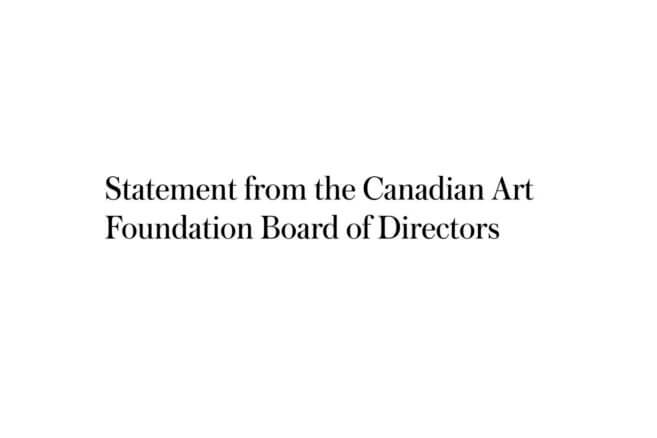Hundreds of thousands of people marched in the streets across Canada last week for the Global Climate Strike, calling for widespread action on climate change.
Art was visible at many of the protests. Banners made from freely downloadable templates by Onaman Collective artists Christi Belcourt and Isaac Murdoch, for instance, were seen at marches in Victoria, Montreal and Vancouver, among other locations.
But how did Canadian arts institutions participate or show support? It varied.
Emily Carr University of Art and Design in Vancouver cancelled classes for the strike. “We know that many of you care deeply about this global priority and have taken action in your daily lives. Some of you have created work that engages with pressing environmental concerns, or have produced research that tackles questions about the future of our planet,” observed ECUAD president Gillian Siddall in a statement.
Maddy Phillips, a fourth-year communications design student at ECUAD, told Canadian Art that being able to participate in the strike felt very “positive.” Phillips has had her eye on sustainability at the school for quite some time; earlier this year, she led a one-day waste audit of the school and co-curated an exhibition about waste using some of the materials collected during the audit in an installation. She also spoke to many fellow students about the issue as part of her project research.
“I hope the school takes into account student perspectives of how they want to see Emily Carr [University] tackle this issue,” Phillips tells Canadian Art. “It takes more than just cancelling classes for actionable change to happen.” Phillips said she would like to see better recycling system installed on campus, and a zero-waste cafeteria, as well as an improved mug-share system and continued support of creative reuse initiatives like the school’s stationery project.
Meanwhile, NSCAD University provided students academic amnesty for the strike, meaning students could miss classes on September 27 without penalty. “From our perspective, we couldn’t in good faith not support our students, but also our staff and faculty who might want to participate in the demonstration,” said NSCAD president Aoife Mac Namara in Halifax Today. (NSCAD also made power and access to its facilities available to the organizers of the local Party for the Planet.) And the OCAD University Student Union led a walkout Friday, stating on Facebook that “As members of OCADU and as Artists and Designers it is our duty to prioritize sustainability, consider new and innovative approaches to issues like climate change, and stand up for our future.”
But while artists, art students and art schools spoke out, major museums and art galleries seemed to make few gestures toward the Global Climate Strike event.
And that concerns Robert R. Janes, a former Calgary museum curator who founded the Coalition of Museums for Climate Justice in 2016 to try and advocate for action in the exhibiting-institutions sector.
“There’s irony, because it’s often artists who are leading the way, but it seems like big art museums are some of the most conservative institutions in our country,” says Janes, who recently co-edited the book Museum Activism.
Climate Strike activists last week staged a “die-in” outside the Canadian Museum for Human Rights in Winnipeg as well as outside the Vancouver Art Gallery. But neither museum acknowledged the Climate Strike on its Twitter or Facebook feeds. This contrasted with the approach of some other museums, like the Montreal Museum of Fine Arts, which posted Facebook photos of employees participating in the Climate Strike, and the McCord Museum in Montreal, which posted to say some of its staff were going.
“Museums are largely a mirror of society,” Janes admits. “You see the same unevenness of progressive and reactionary behaviour that you do in society as a whole.”
Janes feels most hopeful when he sees what is happening at small and medium-size museums and galleries, rather than larger spaces.
“Three provincial museum associations—the Alberta Museum Association, the Ontario Museum Association and the BC Museums Association—have demonstrated clear commitments to climate action,” Janes notes. “Like any other organization, the bigger [museums and galleries] get, the less agile they are.”
There are also other biases major museums and galleries need to overcome to be effective on taking climate change action.
“One of the paramount obstacles to changing museums’ behavior is this claim of neutrality—of senior staff or boards claiming ‘we have to be neutral, because we don’t want to be affected by any special interest group or fads,’” Janes explains. “But that’s nonsense: No museum is neutral. It always reflects the society in which it works and lives.”
Hierarchies and power structures in major museums and art galleries can also slow climate action there: Janes says museum directors “have far too much authority” and that there needs to be more agency provided to wider staffs.
“Another big obstacle are museum boards—more and more consist of businesspeople who put money and economics above any other value,” says Janes. “In Canada especially, oil money can be really big for museum and exhibition sponsorships, and museums and galleries and their boards don’t want to bite the hand that feeds them.”
Janes hopes that the wake of the climate strike provides the impetus to change those patterns.
“I think museums could do a lot to contribute positively to confront the climate challenge,” Janes says. “Not only are they well positioned to act, they are community-based, they are knowledge-based and they bear witness by telling truths…. I think they have potential to be forces for good in this whole issue. But time is really of the essence.”
Phillips wants to keep conversation going too.
“Something I found in my [waste project] research was that either people were really tired of this conversation, or people had no idea it was going on,” says Phillips. “It was either one or the other sometimes. So I think it still needs to be said, and I think art institutions in general should be taking this on and making it more well known.”





